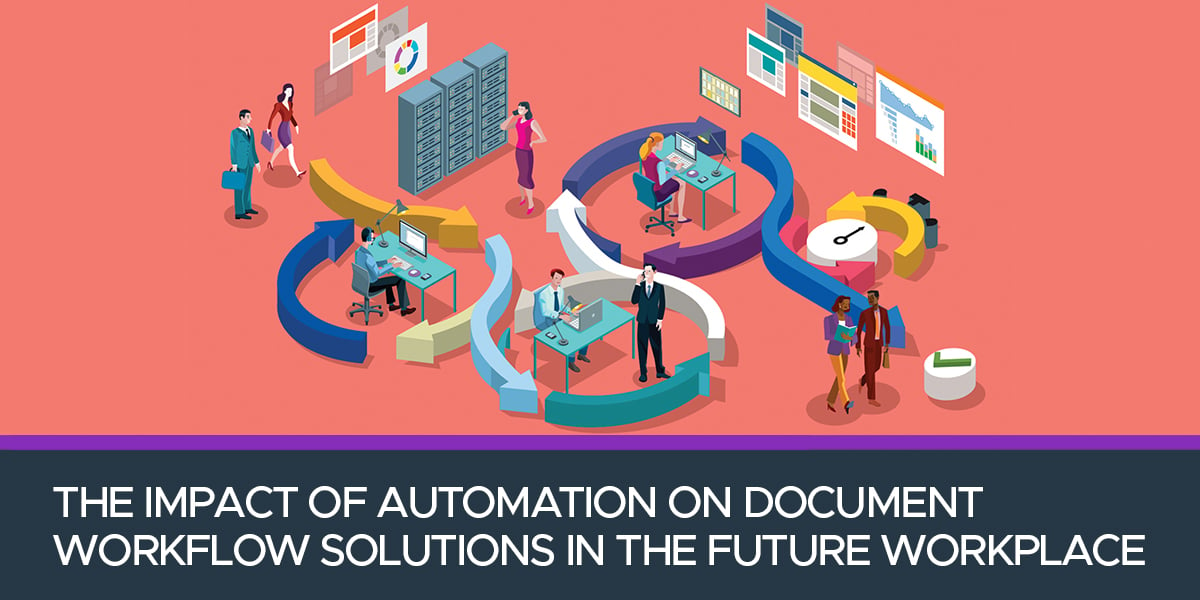The Impact of Automation on Document Workflow Solutions in the Future Workplace

Workplace automation. It is the next big trend in the modern office as more and more businesses recognize the value of strategically deploying this powerful tool. Automation will have a significant impact on document workflow solutions in the future workplace. Process automation means more time spent focusing on high-value business activities, a reduction of errors in a workflow, and an increased ability to nimbly handle the massive amounts of data and documents which are a reality for the modern business.
In other words, p
Drive Productivity in Critical Processes
Process automation is the use of technology to automate day-to-day business tasks. It amplifies office efficiency by taking over laborious, but nonetheless, critical tasks. These include, but are not limited to:
- Highly repetitive and cyclical tasks, such as data entry or payroll.
- Precision tasks where volume prohibits the ability to look over each instance, such as print quality control.
- Document delivery, such as mailing.
- Low-skill labor, such as document capture and archival.
- Tasks that must occur in real-time beyond regular business hours.
- Disaster recovery and business continuity activities.
Process automation makes workflow processes faster, smoother, and more efficient. It makes sure critical but often invisible processes – such as backups or patches – do not get overlooked. Moreover, it drives productivity in daily office workflows.
Process Automation Makes Document Workflow Solutions Effortless
Process automation is especially useful in areas where an office must handle large amounts of data without error, such as in the case of document workflows. Documents and digital files are the lifeblood of many businesses. The modern business is expected to handle reports and data rapidly, and to do it with professionalism and poise.
Fortunately, process automation makes document workflows effortless through an array of different strategies. Increase productivity by leveraging automation at any point of the document life cycle, including:
1. Document Capture and Processing
Automated document capture means that forms and communications are routed directly to relevant personnel. This means no more vital pieces of information or contracts disappearing in an inbox or on a cluttered desk. Instead, information gets delivered to the right people, at the right time.
2. Transmission and Distribution
Automated electronic data interchanges handle the transmission or distribution of invoices or other documents automatically. Likewise, process automation can integrate with other parts of an office workflow to automatically deliver documents to servers, specific individuals, or even the printer.
3. Data Collation
Collation refers to the assembly of information into a standardized format. In other words, it is a way of organizing a body of documents into a uniform, searchable format. For example, offices may employ automated collation to standardize document file names prior to classification. By doing this it makes it easier to find in the future. This feature helps Accounts Payable departments to capture and validate data, categorize invoices, and match and validate invoices to specific accounts.
4. Archival and Storage
Document archival and storage constitute one of the most common areas in which process automation is employed in the document workflow. A solid automated document workflow helps keep records in order so that employees do not need to spend time searching – or reprinting – a misplaced document. HR departments benefit immensely from this. They are able to easily store and archive employee benefits and information, track timesheets, and complete employee payroll with no issues.
5. Document Security
Automated workflow solutions assist a business in maintaining a secure document environment. Consumers have a zero-tolerance for errors, especially when those errors result in consumer data being exposed in a breach. Errors such as misfiling, printing the wrong items, or sending a document to the wrong person are all but eliminated with process automation. Employees and clients can enjoy faster delivery, with fewer errors, and the assurance that their data remains secure.
Get Next-Generation Document Workflow Solutions with RJ Young
The future of the workplace as a whole does indeed lie in automation. Manual processes are increasingly outdated and will hamper an organization’s ability to respond swiftly and adequately to new information or shifting markets. Thoughtfully deployed process automation will inspire new levels of productivity and innovation.
Document workflow solutions represent one area where modern offices are keen to apply process automation because of the tremendous time and cost-savings benefits it confers. Say goodbye to lost documents, forgotten attachments, and a lack of standardization among file names which makes the archives impossible to search. Process automation is driving greater efficiency, organization, and security in document management.
Interested in discovering how process automation can augment your office workflow? Contact RJ Young today to explore the next generation of document management.